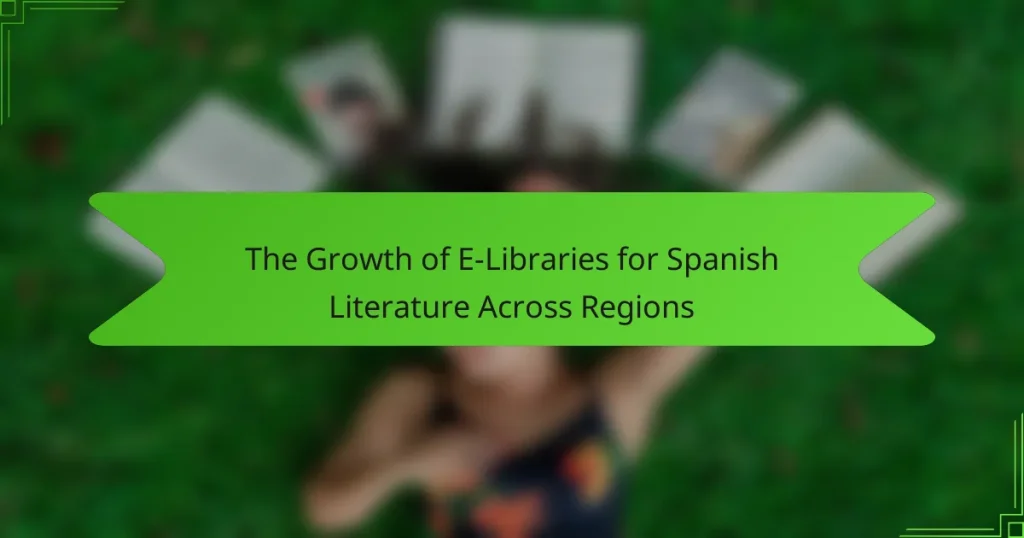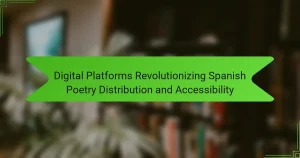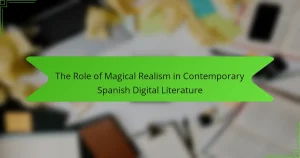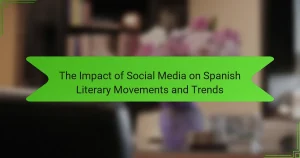E-libraries are transforming access to Spanish literature, enabling readers to explore diverse texts without geographical constraints. This article examines the growth of e-libraries in Spain, Mexico, and Argentina, highlights the unique features enhancing user engagement, discusses challenges in visibility and accessibility, and explores future trends driven by technology and community initiatives. As these digital platforms evolve, they play a crucial role in democratizing access to Spanish literary culture.
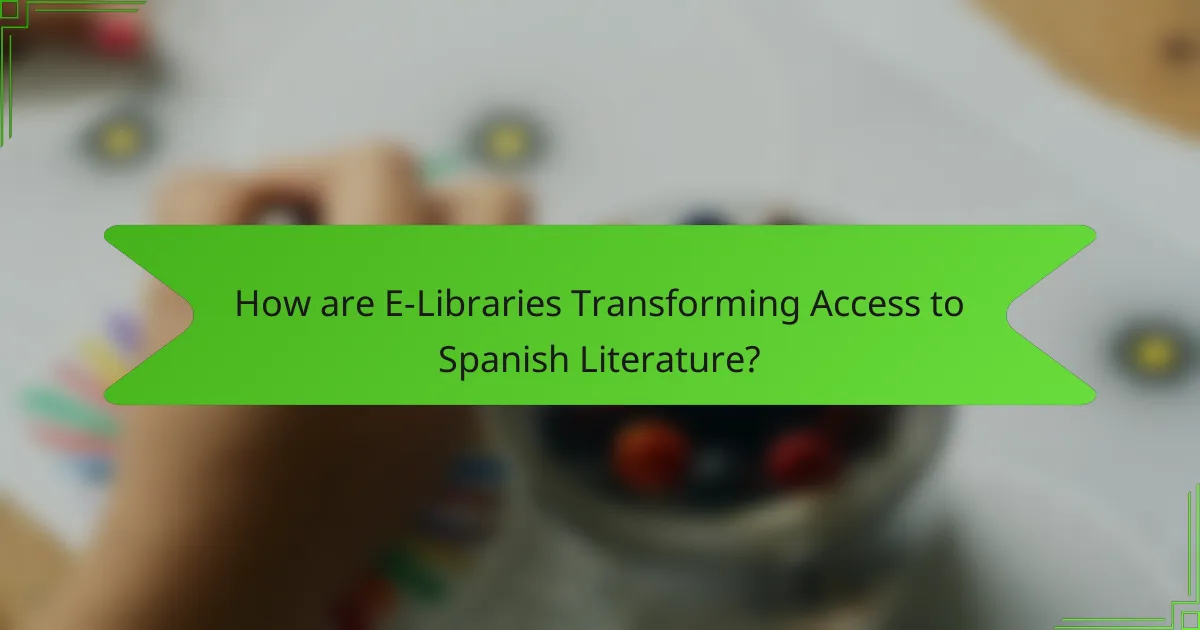
How are E-Libraries Transforming Access to Spanish Literature?
E-libraries are significantly enhancing access to Spanish literature by providing diverse digital resources. They enable readers from various regions to discover, borrow, and enjoy a vast array of works without geographical limitations. This shift democratizes access, allowing for increased engagement with Spanish literary culture.
The growth of e-libraries has led to increased availability of rare and unique Spanish texts, often not found in traditional libraries. For instance, many e-libraries now offer extensive collections of works by contemporary Spanish authors, expanding readers’ exposure to modern literature.
As a result, e-libraries are reshaping how literature is consumed, fostering a sense of community among Spanish-speaking readers globally. They also support educational initiatives by providing students with easy access to essential literary works, enhancing learning opportunities.
In summary, the transformation brought by e-libraries is profound, making Spanish literature more accessible and enriching the cultural landscape for readers worldwide.
What Benefits Do E-Libraries Offer to Readers of Spanish Literature?
E-libraries significantly enhance access to Spanish literature by offering convenience, diverse selections, and affordability. Readers can explore vast collections without geographical limitations, ensuring a richer literary experience.
These platforms often feature unique attributes, such as curated collections that highlight regional authors or themes. Additionally, many e-libraries provide interactive elements, like author interviews and discussion forums, fostering community engagement among readers.
As a result, e-libraries play a crucial role in promoting literacy and cultural appreciation in the Spanish-speaking world. Their growth reflects a broader trend towards digital access in literature, making it easier for readers to discover and enjoy Spanish literary works.
How Do E-Libraries Enhance the Preservation of Spanish Literary Works?
E-libraries significantly enhance the preservation of Spanish literary works by providing digital access and archiving capabilities. They offer a platform for storing rare texts and manuscripts, ensuring their longevity. E-libraries also facilitate the distribution of literature across diverse regions, increasing readership and engagement. As a result, more Spanish literary works can be preserved and appreciated globally, with minimal physical degradation.
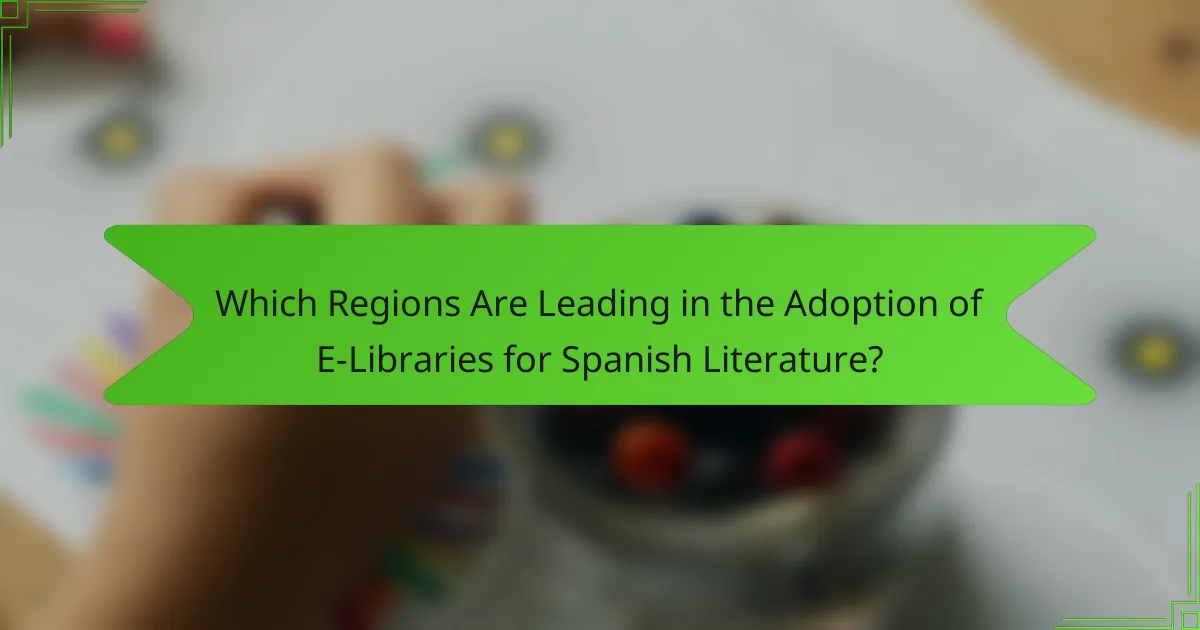
Which Regions Are Leading in the Adoption of E-Libraries for Spanish Literature?
Spain, Mexico, and Argentina are leading in the adoption of e-libraries for Spanish literature. These regions have embraced digital platforms to enhance access to literary works. Spain’s robust digital infrastructure supports extensive e-library services, while Mexico has seen significant growth in user engagement. Argentina’s cultural emphasis on literature drives its e-library expansion. Collectively, these countries exemplify the increasing trend of digitizing Spanish literature for broader accessibility.
What Factors Influence E-Library Growth in Spain?
Several factors influence the growth of e-libraries for Spanish literature across regions. Accessibility to digital resources enhances user engagement. Technological advancements improve user experience and content delivery. Government initiatives promote digital literacy and resource funding. Additionally, cultural interest in Spanish literature drives demand for diverse offerings. Collaboration between institutions expands the range of available materials, fostering community involvement.
How Are E-Libraries Expanding in Latin America?
E-libraries are rapidly expanding in Latin America, enhancing access to Spanish literature. This growth is driven by increasing internet connectivity and digital literacy across the region.
Statistics show that over 70% of Latin Americans now have internet access, enabling more users to engage with e-libraries. Countries like Mexico and Argentina lead in digital library initiatives, offering vast collections of Spanish literary works.
Moreover, unique collaborations between governments and tech companies are fostering the development of digital platforms that host local authors. These initiatives not only preserve cultural heritage but also promote reading among younger generations.
As a result, e-libraries are becoming vital resources for education and cultural exchange, transforming how Spanish literature is consumed in Latin America.

What Unique Features Do E-Libraries Provide for Spanish Literature?
E-libraries for Spanish literature offer unique features that enhance accessibility and engagement. They provide a vast collection of digital texts, enabling readers to access works from various authors and regions without geographical limitations. Many e-libraries include interactive elements, such as annotations and multimedia resources, which enrich the reading experience. Additionally, they often feature advanced search capabilities that help users discover specific themes or genres within Spanish literature. Lastly, e-libraries frequently support multiple languages, broadening the audience for Spanish literary works.
How Do E-Libraries Cater to Diverse Reader Preferences in Spanish Literature?
E-libraries effectively cater to diverse reader preferences in Spanish literature by offering a wide range of genres and formats. They provide access to classic and contemporary works, ensuring inclusivity for various tastes. Additionally, e-libraries often feature personalized recommendations and user-driven ratings, enhancing the reading experience. The ability to access materials in multiple dialects and regional variations further supports diverse readership. Furthermore, e-libraries frequently update their collections, reflecting current trends and reader interests, which encourages ongoing engagement with Spanish literature.
Which Innovative Technologies Are Being Used in E-Libraries for Spanish Literature?
Innovative technologies enhancing e-libraries for Spanish literature include digital archiving, mobile applications, and AI-driven recommendations. These advancements improve accessibility and user experience across diverse regions. For example, AI algorithms analyze reading patterns to suggest relevant texts, enriching the literary exploration process. Additionally, cloud storage ensures vast collections are easily accessible, supporting the growth of Spanish literature in the digital age.
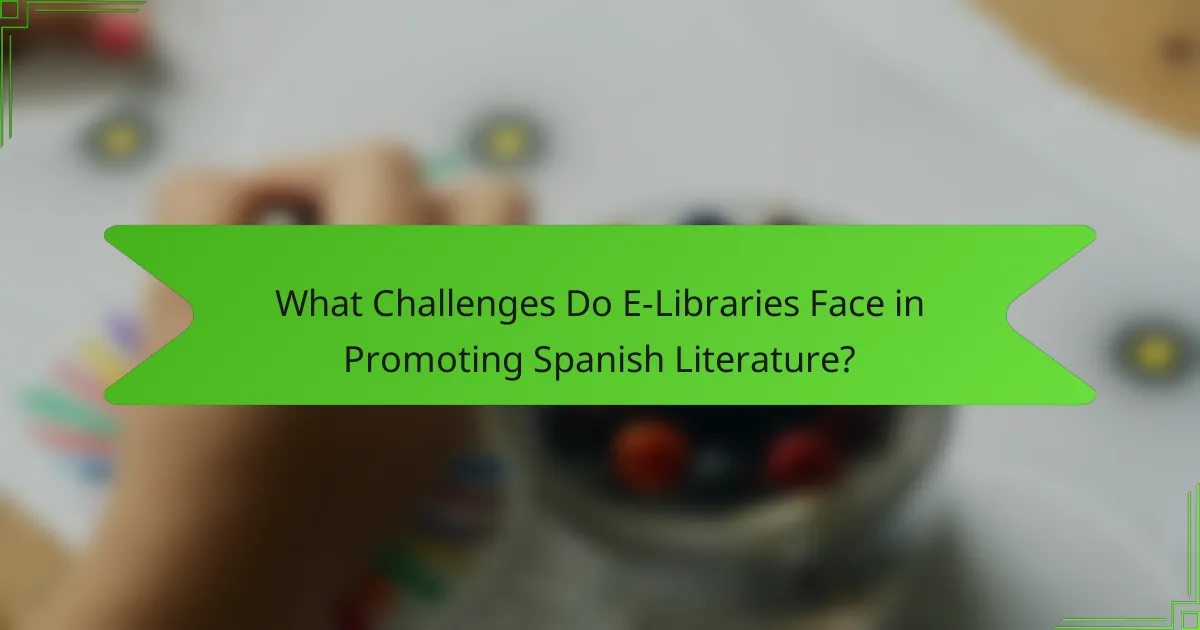
What Challenges Do E-Libraries Face in Promoting Spanish Literature?
E-libraries face several challenges in promoting Spanish literature, including limited visibility, language barriers, and insufficient funding. These barriers hinder access to diverse literary works and reduce reader engagement.
Additionally, many e-libraries lack marketing strategies tailored to reach Spanish-speaking audiences effectively. As a result, potential readers may not discover valuable resources.
Technological disparities across regions also impact the growth of e-libraries, as not all areas have equal internet access or digital literacy levels. This exacerbates the challenge of promoting Spanish literature effectively.
Lastly, copyright issues can restrict the availability of certain works, limiting the range of literature that e-libraries can offer to their users. Addressing these challenges is crucial for enhancing the reach and impact of Spanish literature in the digital space.
How Do Digital Divide Issues Affect Access to E-Libraries?
Digital divide issues significantly hinder access to e-libraries, particularly for Spanish literature. Limited internet access and digital literacy create barriers for users in underserved regions. This disparity affects the availability of resources and the ability to engage with diverse literary works. As a result, communities with inadequate digital infrastructure miss out on the cultural and educational benefits offered by e-libraries.
What Legal and Copyright Challenges Impact E-Libraries for Spanish Literature?
Legal and copyright challenges significantly impact e-libraries for Spanish literature, hindering access and distribution. Copyright laws often restrict digital reproduction and sharing, limiting the availability of texts. Additionally, regional differences in copyright enforcement create inconsistencies in access across countries. The public domain status of works varies, affecting which texts can be freely distributed. Enforcement of copyright can lead to legal disputes, discouraging libraries from expanding their digital collections. As a result, these challenges can stifle the growth of e-libraries, ultimately affecting readers’ access to Spanish literature.
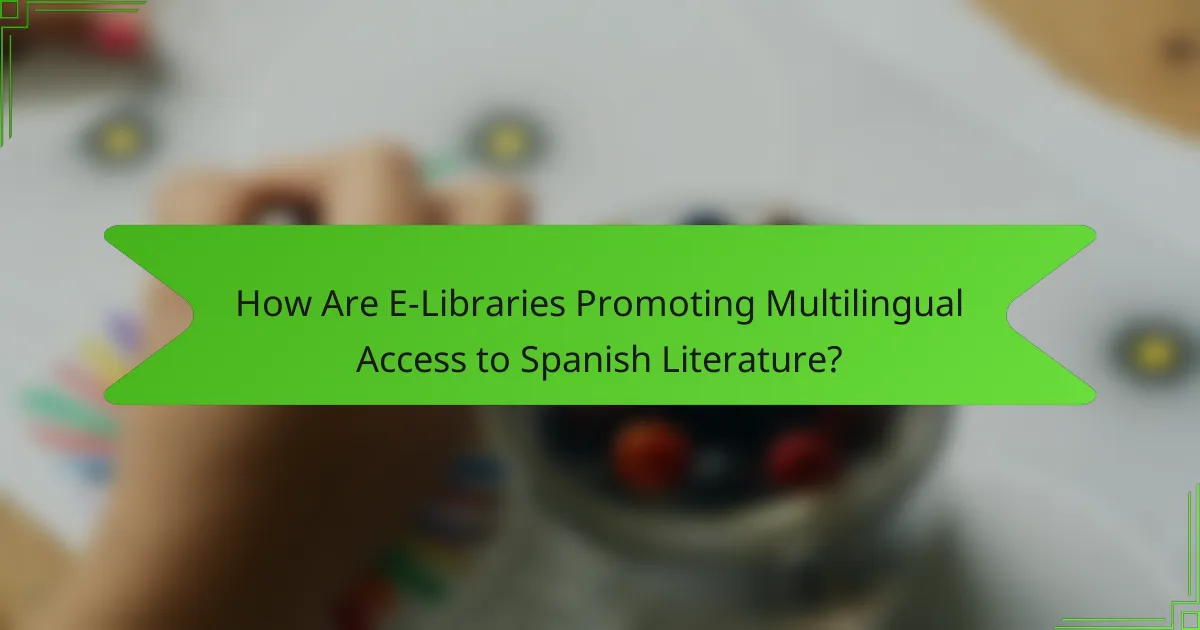
How Are E-Libraries Promoting Multilingual Access to Spanish Literature?
E-libraries are enhancing multilingual access to Spanish literature by providing diverse digital resources. They offer vast collections of Spanish texts that cater to various linguistic backgrounds. Users can access literature in multiple dialects and formats, promoting inclusivity. Additionally, e-libraries employ translation tools and multilingual interfaces, making it easier for non-Spanish speakers to engage with the content. This approach fosters cultural exchange and broadens the audience for Spanish literature globally.
What Role Do E-Libraries Play in Supporting Bilingual Readers?
E-libraries significantly enhance access to Spanish literature for bilingual readers, fostering language development and cultural understanding. They provide a diverse range of texts, enabling readers to practice both languages. E-libraries facilitate immediate access to resources, allowing users to explore literature from various regions, which supports bilingual education. Additionally, they often include features like translation tools and audio support, which cater to the needs of bilingual readers, making literature more accessible and engaging.
How Are E-Libraries Facilitating Cross-Cultural Literary Exchanges?
E-libraries are enhancing cross-cultural literary exchanges by providing accessible platforms for Spanish literature. They connect diverse readers and authors, fostering cultural appreciation and dialogue.
These digital libraries host a vast range of Spanish literary works, including classic and contemporary texts. As a result, they facilitate the discovery of unique voices from different regions, enriching readers’ experiences.
E-libraries also support multilingual access, allowing users to explore Spanish literature alongside translations in various languages. This accessibility broadens the audience and encourages intercultural understanding.
Moreover, e-libraries often feature community forums and discussion groups. Such platforms enable readers to share insights and interpretations, promoting collaborative learning and cultural exchange.

What Future Trends Are Expected in the Growth of E-Libraries for Spanish Literature?
The growth of e-libraries for Spanish literature is expected to see significant advancements driven by technology and user demand. Increased digitization efforts will enhance access to diverse literary works across regions.
Emerging trends include the integration of artificial intelligence to personalize reading experiences and recommendations. Furthermore, mobile accessibility will expand readership, particularly among younger demographics.
Collaborations between authors, publishers, and e-library platforms will foster exclusive content offerings, attracting more users. Additionally, multilingual features will cater to non-Spanish speakers, broadening the audience base.
Finally, community-driven initiatives will promote local literature, ensuring regional voices are represented in the digital space. This holistic approach positions e-libraries as vital resources for Spanish literature’s future growth.
How Will User Behavior Shape the Evolution of E-Libraries?
User behavior will significantly influence the evolution of e-libraries for Spanish literature by driving demand for accessibility and personalization. As more readers seek digital formats, e-libraries will adapt by expanding their collections and improving user interfaces.
Increased mobile usage will lead to more mobile-friendly platforms, enhancing user experience. Data analytics will help libraries understand reading habits, allowing for tailored recommendations.
Furthermore, social interactions within e-libraries will grow, fostering community engagement around Spanish literature. This trend will encourage collaborative reading and discussions, creating a vibrant digital literary culture.
Overall, user behavior will shape e-libraries into more dynamic and responsive platforms, enhancing access to Spanish literature across various regions.
What Strategies Can E-Libraries Implement to Enhance Engagement with Spanish Literature?
E-libraries can enhance engagement with Spanish literature by implementing targeted strategies. These include curating a diverse collection, promoting interactive reading experiences, and hosting virtual events featuring Spanish authors.
Offering personalized recommendations based on user preferences can also boost engagement. Additionally, incorporating community forums for discussions around Spanish literature fosters a sense of belonging. Finally, utilizing social media to share highlights and updates can attract a broader audience.
What Best Practices Should E-Libraries Follow to Optimize Access to Spanish Literature?
E-libraries should prioritize user-friendly interfaces, diverse formats, and robust search functionalities to optimize access to Spanish literature.
1. Implement intuitive navigation to enhance user experience.
2. Offer multiple formats, such as e-books, audiobooks, and PDFs, to cater to different preferences.
3. Ensure comprehensive search functionalities that allow filtering by genre, author, and language.
4. Promote community engagement through forums and book clubs to foster a love for Spanish literature.
5. Regularly update collections with contemporary and classic works to maintain relevance.
6. Collaborate with local authors and publishers to feature regional literature.
